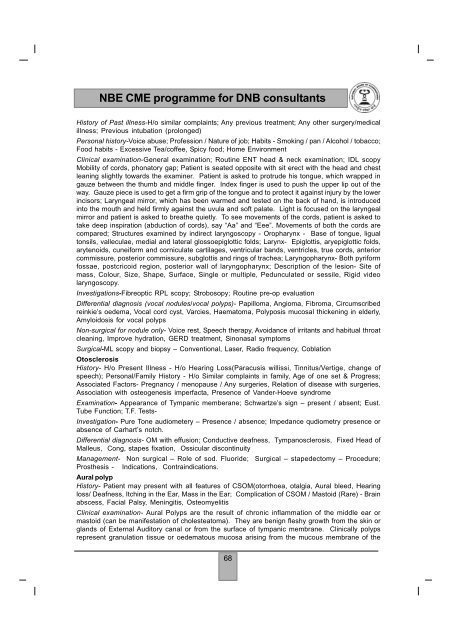NBE CME programme for DNB consultants - National Board Of ...
NBE CME programme for DNB consultants - National Board Of ...
NBE CME programme for DNB consultants - National Board Of ...
You also want an ePaper? Increase the reach of your titles
YUMPU automatically turns print PDFs into web optimized ePapers that Google loves.
<strong>NBE</strong> <strong>CME</strong> <strong>programme</strong> <strong>for</strong> <strong>DNB</strong> <strong>consultants</strong>History of Past illness-H/o similar complaints; Any previous treatment; Any other surgery/medicalillness; Previous intubation (prolonged)Personal history-Voice abuse; Profession / Nature of job; Habits - Smoking / pan / Alcohol / tobacco;Food habits - Excessive Tea/coffee, Spicy food; Home EnvironmentClinical examination-General examination; Routine ENT head & neck examination; IDL scopyMobility of cords, phonatory gap; Patient is seated opposite with sit erect with the head and chestleaning slightly towards the examiner. Patient is asked to protrude his tongue, which wrapped ingauze between the thumb and middle finger. Index finger is used to push the upper lip out of theway. Gauze piece is used to get a firm grip of the tongue and to protect it against injury by the lowerincisors; Laryngeal mirror, which has been warmed and tested on the back of hand, is introducedinto the mouth and held firmly against the uvula and soft palate. Light is focused on the laryngealmirror and patient is asked to breathe quietly. To see movements of the cords, patient is asked totake deep inspiration (abduction of cords), say “Aa” and “Eee”. Movements of both the cords arecompared; Structures examined by indirect laryngoscopy - Oropharynx - Base of tongue, ligualtonsils, valleculae, medial and lateral glossoepiglottic folds; Larynx- Epiglottis, aryepiglottic folds,arytenoids, cunei<strong>for</strong>m and corniculate cartilages, ventricular bands, ventricles, true cords, anteriorcommissure, posterior commissure, subglottis and rings of trachea; Laryngopharynx- Both pyri<strong>for</strong>mfossae, postcricoid region, posterior wall of laryngopharynx; Description of the lesion- Site ofmass, Colour, Size, Shape, Surface, Single or multiple, Pedunculated or sessile, Rigid videolaryngoscopy.Investigations-Fibreoptic RPL scopy; Strobosopy; Routine pre-op evaluationDifferential diagnosis (vocal nodules/vocal polyps)- Papilloma, Angioma, Fibroma, Circumscribedreinkie’s oedema, Vocal cord cyst, Varcies, Haematoma, Polyposis mucosal thickening in elderly,Amyloidosis <strong>for</strong> vocal polypsNon-surgical <strong>for</strong> nodule only- Voice rest, Speech therapy, Avoidance of irritants and habitual throatcleaning, Improve hydration, GERD treatment, Sinonasal symptomsSurgical-ML scopy and biopsy – Conventional, Laser, Radio frequency, CoblationOtosclerosisHistory- H/o Present Illness - H/o Hearing Loss(Paracusis willissi, Tinnitus/Vertige, change ofspeech); Personal/Family History - H/o Similar complaints in family, Age of one set & Progress;Associated Factors- Pregnancy / menopause / Any surgeries, Relation of disease with surgeries,Association with osteogenesis imperfacta, Presence of Vander-Hoeve syndromeExamination- Appearance of Tympanic memberane; Schwartze’s sign – present / absent; Eust.Tube Function; T.F. Tests-Investigation- Pure Tone audiometery – Presence / absence; Impedance qudiometry presence orabsence of Carhart’s notch.Differential diagnosis- OM with effusion; Conductive deafness, Tympanosclerosis, Fixed Head ofMalleus, Cong, stapes fixation, Ossicular discontinuityManagement- Non surgical – Role of sod. Fluoride; Surgical – stapedectomy – Procedure;Prosthesis - Indications, Contraindications.Aural polypHistory- Patient may present with all features of CSOM(otorrhoea, otalgia, Aural bleed, Hearingloss/ Deafness, Itching in the Ear, Mass in the Ear; Complication of CSOM / Mastoid (Rare) - Brainabscess, Facial Palsy, Meningitis, OsteomyelitisClinical examination- Aural Polyps are the result of chronic inflammation of the middle ear ormastoid (can be manifestation of cholesteatoma). They are benign fleshy growth from the skin orglands of External Auditory canal or from the surface of tympanic membrane. Clinically polypsrepresent granulation tissue or oedematous mucosa arising from the mucous membrane of the68
















